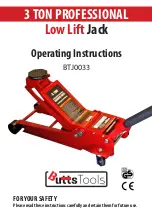
BEDIENUNGS- UND WARTUNGSANLEITUNG
INSTRUCTION MANUAL
3. Transport und Lagerung
3.1 Transport
Der Bedienungspumphebel (02) ist nur zur Bedienung
des Hebers geeignet. Der Transport des Hebers hat
schonend zu erfolgen. Das Fallenlassen oder das
Werfen des Gerätes schädigt den Zylinder und die
Pumpe. Vor dem Transport im Fahrzeug muss er sorg-
fältig verstaut und befestigt werden.
3.2 Lagerung
Bewahren Sie den Heber an einem trockenen Ort auf.
4. Inbetriebnahme
Die Inbetriebnahme des Hebers ist sehr einfach. Sie
müssen nur den Bedienungshebel (02) in die Halterung
(04) stecken und ihn im Uhrzeigersinn festdrehen.
5. Bedienung
5.1 Vorbereitung
Vor dem Gebrauch ist der Heber auf eine sichere und
feste Unterlage zu stellen, z.B. dem verstärktem
Betonboden, um Lasten horizontal oder vertikal zu be-
wegen. Wenn die Höhe nicht ausreicht, so sind stabile
Podestplatten unter den Heber zu legen. Die verzahnte
Klaue (43) ist in die tiefste Position zu senken, um größt-
möglichen Hub zu gewähleisten, wenn der Heber unter-
geschoben wird.
5.2 Bedienungsmethoden
5.2.1 Heben
Belasten Sie die Hubklaue (43)!
Achtung: Nicht die Last auf die Spitze setzen!
Wichtig: Beim Heben mit der Klaue ist die Last bis ganz
an die Säule zu plazieren, um nicht bei Belastung die
Führung und den Kolben (47) zu verbiegen. Dann das
Stellrad (16) im Uhrzeigersinn fest eindrehen.
5.2.2 Senken (Entlasten)
Bitte das Stellrad (16) langsam gegen den Uhrzeiger-
sinn drehen, um das Gewicht Schritt für Schritt zu sen-
ken. Wird das Stellrad schnell in die Gegenrichtung
zurückgedreht, stopt der Senkvorgang sofort.
Anmerkung: Der unbelastete Heber kann durch Drücken
mit der Hand auf den Kopf abgesenkt werden.
Achtung: Solange der Heber im Einsatz ist, darf und
kann kein Teil demontiert werden außer der
Bedienungshebel.
5.3 Sicherheit
5.3.1 Das Heben von Lasten ist eine gefahrvolle
Tätigkeit. Sie darf nur von professionellen, geschulten
und erfahrenen Personen ausgeführt werden.
5.3.2 Es dürfen keine zusätzlichen Lasten mehr auf den
Heber gepackt werden, wenn er die Nennlast schon
angehoben hat.
5.3.3 Den Heber niemals überlasten!
5.3.4 Immer einen Sicherheitsabstand zur angehobenen
Last einhalten!.
5.3.5 Niemals den Heber benutzen, wenn er verändert,
beschädigt oder in schlechtem Zustand ist!
5.3.6 Beim Heben mit der Klaue ist die Last ganz auf die
Pratze aufzusetzen. Beachten Sie die Zeichnung Nr. 2!
5.3.7 Vergewissern Sie sich, dass der Untergrund stabil
genug ist, die Last auf einen Punkt zu konzentrieren und
dass die Aufstellfläche und die Lastangriffsfläche eben
3. Transportation & storage
3.1 Transportation
The operating handle (02) is just for operating the jack.
When transporting the jack, it can not be dropped or be
thrown because it may cause the piston of it damaged,
and the pump of it might be spoiled. Therefore, the
jack should be fixed before transporting to avoid it being
shocked by other objects.
3.2 Storage
Keeping the folded jack in a dry place.
4. Installation
The installing of jack is very simple The only thing you
should follow is to insert the operating handle (02) to the
socket (04) and screw it tightly in clockwise direction.
5. Operating
5.1 Scope of use
When use this jack, it shall be put on the fixed and solid
place, such as reinforced concrete floor, to lift or to move
load vertically or horizontally, !n order to lift load in such
limited area of jack, some auxiliary pad can be placed
under the base of it. The tooth plate (43) of jack should
be put on the base, so that it can be folded inside when
retracting the jack.
5.2 Method of operating
5.2.1 Lifting
Put a weight on the tooth plate of jack stable.
Attention: Can not use the front end of tooth plate to lift
the weight. Important point: When lifting the weight by
the tooth plate, the weight should be close to the head
of jack to avoid the pillar (47) of jack being bent.
Please screw in the unloaded handle (16) tightly in
clockwise direction before lifting.
5.2.2 Reducing (Lowering)
Screw out the unload handle slowly in anti-clockwise
direction to reduce the weight step by step. But when
screw up the round unload handle again, the reducing
movement can be stopped instantly.
Note: When the jack is in unloaded condition, the head
of it should be pressed to reduce its height.
Attention: If the jack is not in the state of maintaining,
each part of it can not be dismantled except the opera-
ting handle.
5.3 Safety standard
5.3.1 The lifting of weight is dangerous operation, the
appointed operators should be professional, be trained
and be experienced.
5.3.2 Those extra weights can not be added on the lifted
weight to avoid dropping accident happening.
5.3.3 Never exceed the recommended maximum limita-
tion of lifting weight.
5.3.4 Please keep a safety distance with the lifted
weight.
5.3.5 Never use the jack, or being changed or spoilt, or
in bad condition itself.
5.3.6 When lifting the weight by tooth plate, please keep
the weight close to the head of jack to avoid the pillar of
jack being bent. Please check the drawing # 2 again.
5.3.7 Please confirm that each support point of ground
should be solid and stable including floor area and loa-
























